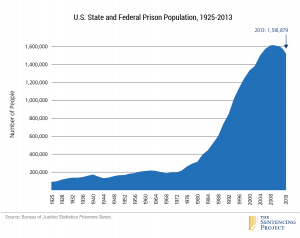Executive Summary
Mass incarceration is an imm issue in the United States, where funding is being given to creating more prisons rather than to education, health care, or other programs designed to ensure individuals don’t end up incarcerated in the first place.
Scope of the Problem
This topic is important because it affects such a large percentage of our nation’s population. Although the United States comprises just 5% of the world’s population, U.S. citizens represent about 25% of those incarcerated. This doesn’t necessarily mean that our country is made up of a population that is that much more criminally minded than the rest of the world, just that we like to lock people up more. Overcrowding in prisons is also a major problem. The rate of incarceration has dramatically increased in the last 30 years, but the number of prisons has not kept up with these numbers. It’s an incredibly expensive business that our nation partakes in, and not necessarily for the right reasons. People should be locked up because they are a danger to our society or in need of rehabilitation, not simply because we’re mad at them. It is a broken system.
People should care because it is our future at stake. It is also a self-fulfilling prophecy that people of color end up incarcerated because our society sets them up for it. Rather than providing a means for people to be able to support themselves or believe they can contribute to the world in a positive fashion, children learn from an early age that they are not worthy and once they are a part of the system it is incredibly difficult to succeed at getting themselves out of it. If we want the cycle to end, it is important to see that it is the system, not simply bad individuals, that is leading to more and more people being locked up. Crime rates have not continued rising, but harsher sentencing laws have left people behind bars longer for lesser crimes. Some states have “Three Strikes Laws” and incredibly harsh penalties for even small drug offenses that send citizens to prison and perpetuate a cycle that has already proven to be less than effective. Recidivism is almost inevitable with all of the hoops criminals must jump through once they do reach parole.
The Facts:
- Incarceration is not color blind.
- The rate of incarceration has dramatically increased in the last 30 years.
- Disenfranchising voters has distorted American democracy. Many citizens who have been personally affected by the prison system due to felony convictions no longer have the right to vote.
- Prisons are incredibly expensive to run and maintain.
- Over 2.4 million people are locked up in the United States.
- The United States incarcerates a greater percentage of its population than any other nation in the world.
- The United States comprises about 5% of the world’s population, but about 25% of those incarcerated.
- Zero tolerance policies adversely affect black students.
- “Get tough on crime” and “war on drugs” policies contribute.
- Incarceration has not proved to be a productive rehabilitation strategy for behavior.
Implications and Recommendations
What you can do:
- Understand the cycle of incarceration. Once a person is a part of the system, it can be incredibly difficult to extricate oneself form it because there are so many hoops to jump through. You can visit http://www.sentencingproject.org/template/page.cfm?id=107 for more information.
- It’s a privilege not afforded to all, and taken away from too many.
- Become a part of the movement. Know what is happening and what you can participate in. https://www.popularresistance.org/tag/mass-incarceration/
Conclusion:
There is still so much to be done to address this massive issue regarding so much of our population. It is important that citizens first acknowledge that mass incarceration is a problem that needs to be addressed and realize that it is a systemic issue rather than simply our society having more and more bad people in it. Citizens should educate themselves more on the issues and fight for changes to be made.
For more information:
Prison State: http://video.pbs.org/video/2365235229/
https://afsc.org/story/facts-about-mass-incarceration-people-color-us
